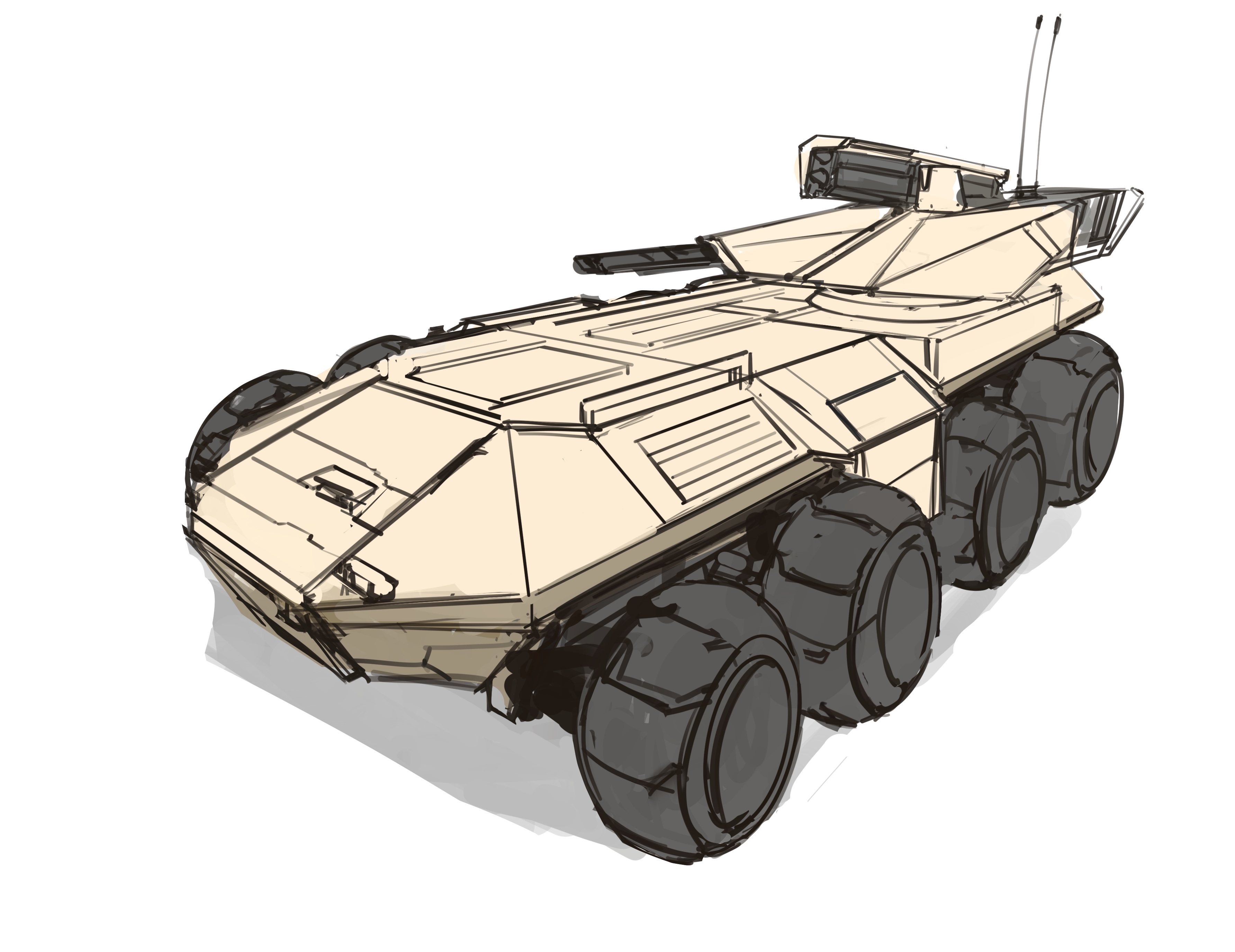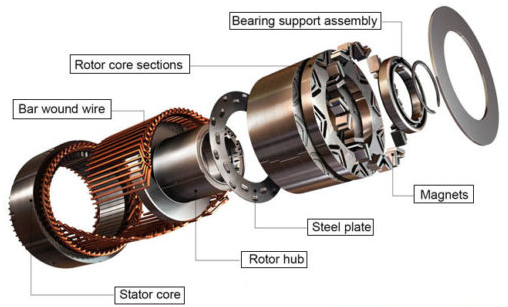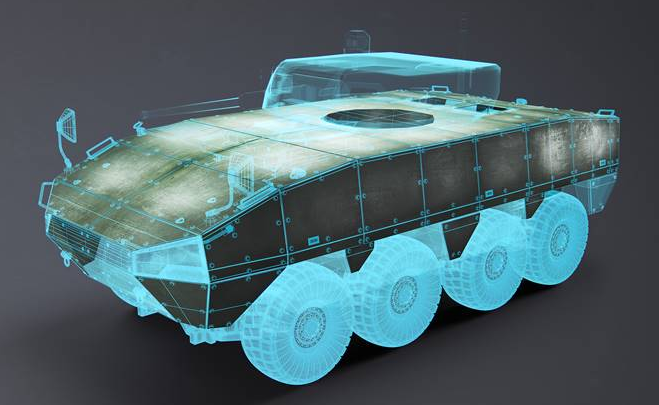Fenrir Dynamics GV-44 'Warden'
Alright, listen up! We've just received these babies from HQ, so I want to make sure that you understand the rules. No racing, no drifting, no puking and absolutely no goddamn cheese in the cooking station, have I made myself clear?
The Warden, commonly referred to as the Universal Ground Vehicle, or UGV, is a family of ten-wheeled amphibious armored vehicles designed and manufactured by Fenrir Dynamics for the Vestan Defense Forces. Conceived as a universal platform, the Warden forms the backbone of the Vestan Ground Defense Force, its hull presenting an excellent balance of protection and mobility for the various roles it has been assigned.
After fifty years of exclusive use by the military, some variants of the Warden were developed for the civilian market. Despite their high cost and limited features compared to military variants, these quickly became a popular hit among police forces and private corporations alike.
History
Development
In the late 290s, the Vestan Defense Forces had adopted a large number of vehicles, covering a variety of roles in different environments. While each of them performed well individually, maintaining and upgrading such a vast and diverse fleet of vehicles was proving to be an arduous task, even for the impressive industrial capabilities of the Federation. As time passes, more and more of these vehicles start to show their age, further accentuating the need for a replacement. Seizing the opportunity, the Vestan Ground Defense Force launched in 298 the Universal Ground Vehicle modernization program, aimed at replacing and unifying its current inventories of ground vehicles. The initial requirements were vague and sometimes contradictory, leading to numerous exchanges between the branches of the VDF and well-established defense contractors. With two hundred years of historic combat data and reliable projections for the next century, the first proposals emerged in the early 300s.
Competing against other designs, the Warden initially proved to be average, if not mediocre, in most of its early trials. Major issues were the poor agility in rough terrain, poorly arranged crew cabin and engines reliability. Still, with the UGV contract destined to be the most profitable success of the century, Fenrir Dynamics poured a significant portion of its engineering teams into the program. These quirks were eventually resolved and other aspects were further improved, turning the Warden into a reliable and versatile chassis. Over the course of two decades of trials, the Ministry of Defense almost cancelled the UGV program five times due to its cost overruns (costing nearly six times the initial budget), but pressure from the GDF, along with the early retirement of numerous vehicles, kept the program afloat until its completion. In 324, Fenrir Dynamics was officially selected to mass produce the newly adopted Warden. The GDF placed an initial order of 50 000 vehicles, with the first batch delivered for the 325 Unity Day parade in Bel Avenir.
Recent history
For the next sixty years, the Warden served as the primary armored vehicle of the GDF, forming the bulk of its mechanized forces. While no major wars were fought during this time, the Warden proved to be a capable vehicle during anti-piracy operations and wildlife control operations. The Maian Insurgency of 379 also showed that it was effective in asymmetrical urban warfare, and constant upgrades and exercises ensure its readiness for any major conflict. All in all, the Warden has become a signature vehicle of the Vestan Defense Forces, with more than half a million units produced and no plans envisioned to replace it.
Design
The Warden is designed to be deployed anywhere, at anytime and under any conditions. For this purpose, it is built around a pressurized compartment housing its crew and potential passengers, with a rear door and two side doors. Its standardized construction facilitates the installation of upgrades, while its passenger compartment can easily be converted into other roles. Another side effect is that repairs and maintenance are greatly simplified by using common parts across the entire family.
Armament
While the Warden's primary armament varies greatly from one variant to another, its secondary array of eight 52mm grenade launchers, four on each side of the crew's compartment, remains accross all variants. These launchers are loaded externally and generally used as close proximity anti-personnel weapons. The 52mm smart grenades have the capability to strike all around the vehicle, with a minimum arming distance of 80cm.

Fenrir Dynamics
Unit cost
23.7 million PLV
No. Built
~540.000
In service
324-present
Mass
Military - 13.1 to 17.8 tons
Civilian - 7.8 to 8.4 tons
Length
8.45m
Width
3.35m
Height
3.2m
Crew
2 (Driver, Commander)
Passengers
1 to 13 passengers
0 to 2 drones
Armor
Class I - Polymer composite armor
Class II - Calfen-reinforced composite armor
Class III - Non-explosive reactive armor
Main Armament
IFV - RF8 60mm autocannon (210 rounds), 4x Lance ATGM
FSV - C51 146mm gun (56 rounds)
MLV - 3x Modular Launch Pod
ADV - EWS-5 280kJ rotary gun
Secondary Armament
"Shredder" 8kJ machine gun, 8x SGL52 52mm grenade launchers
Propulsion
10*80hp permanent magnet synchronous motors / 12 multi-vector maneuvering thrusters / 2 electric waterjets
Operational Range
550-1200 km
Maximum Speed
128 km/h





Some lovely descriptive content here, very well thought out and highly detailed. My only feedback would be around visuals / flow of the article. Play around with the positions of content on the page and try to break up the viewer's journey - take a look at Etrea by Serukis, Melior by Melior or Cathedris by Stormbril. These Authors have great ways of breaking up content through layout and interactive content in their articles!